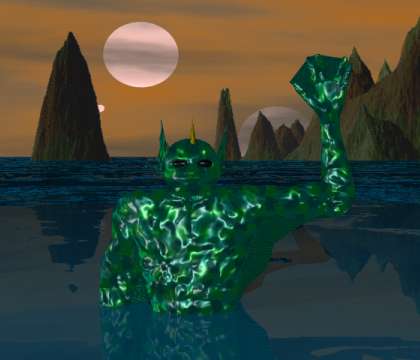|
The Dogon, the Nommos and Sirius B
In Mali, West Africa, lives a tribe of people called the Dogon. The Dogon are believed to be of Egyptian decent and their astronomical lore goes back thousands of years to 3200 BC. According to their traditions, the star Sirius has a companion star which is invisible to the human eye. This companion star has a 50 year elliptical orbit around the visible Sirius and is extremely heavy. It also rotates on its axis. This legend might be of little interest to anybody but the two French anthropologists, Marcel Griaule and Germain Dieterlen, who recorded it from four Dogon priests in the 1930's. Of little interest except that it is exactly true. How did a people who lacked any kind of astronomical devices know so much about an invisible star? The star, which scientists call Sirius B, wasn't even photographed until it was done by a large telescope in 1970. Visitors from the Stars The Dogon stories explain that also. According to their oral traditions, a race people from the Sirius system called the Nommos visited Earth thousands of years ago. The Nommos were ugly, amphibious beings that resembled mermen and mermaids. They also appear in Babylonian, Accadian, and Sumerian myths. The Egyptian Goddess Isis, who is sometimes depicted as a mermaid, is also linked with the star Sirius. The Nommos, according to the Dogon legend, lived on a planet that orbits another star in the Sirius system. They landed on Earth in an "ark" that made a spinning decent to the ground with great noise and wind. It was the Nommos that gave the Dogon the knowledge about Sirius B. The legend goes on to say the Nommos also furnished the Dogon's with some interesting information about our own solar system: That the planet Jupiter has four major moons, that Saturn has rings and that the planets orbit the sun. These were all facts discovered by Westerners only after Galileo invented the telescope. K.G. Temple's Book The story of the Dogon and their legend was first brought to popular attention by Robert K.G. Temple in a book published in 1977 called The Sirius Mystery. Science writer Ian Ridpath and astronomer Carl Sagan made a reply to Temple's book, suggesting that this modern knowledge about Sirius must have come from Westerners who discussed astronomy with the Dogon priests. The priests then included this new information into the older traditions. This, in turn, mislead the anthropologists. This is a possibility considering Sirius B's existence was suspected as early as 1844 and seen was through a telescope in 1862. It doesn't seem to explain a 400-year old Dogon artifact that apparently depicts the Sirius configuration nor the ceremonies held by the Dogon since the 13th century to celebrate the cycle of Sirius A and B. It also doesn't explain how the Dogons knew about the super-density of Sirius B, a fact only discovered a few years before the anthropologists recorded the Dogon stories. It is also important to remember that although many parts of the Dogon legends seem to ring true, other portions are clearly mistaken. One of the Dogon's beliefs is that Sirius B occupied the place where our Sun is now. Physics clearly prohibits this. Also, if the Dogon believe that Sirius B orbits Sirius A every 50 years, why do they hold their celebrations every 60 years? The Sirius System Sirius A is the brightest star in our sky and can easily be seen in the winter months in the northern hemisphere. Look for the constellation Orion. Orion's belt are the three bright stars in a row. Follow an imaginary line through the three stars to Sirius which is just above the horizon. It is bluish in color. Sirius is only 8.6 light years from Earth. Astronomer W.Bessel was the first to suspect that Sirius had an invisible companion when he observed that the path of the star wobbled. In the 1920's it was determined that Sirius B, the companion of Sirius, was a "white dwarf" star. The pull of its gravity caused Sirius's wavy movement. White dwarfs are small, dense stars that burn dimly. Sirius B is, in fact, smaller than the planet Earth. One teaspoon of Sirius B is so dense that it weighs 5 tons. So did alien fish-men pay a visit to ancient Earth and give the Dogon their knowledge? Or was the Dogon's culture contaminated by western visitors? Or could the Dogon's have had ancient technical or non-technical means to find this information out? Or is the whole thing just a matter of coincidence? The question maybe settled as larger and more powerful telescopes take a look at the Sirius system. According to the legend there is a third star: Sirius C, and it is around Sirius C that the home planet of the Nommos orbits. Most scientists do not consider any part of the Sirius system a prime candidate for life, though. When Temple first issued his book in the 1970's there was no solid evidence of a Sirius C. In 1995, however, two French researchers, Daniel Benest and J.L. Duvent, authored an article in the prestigious journal Astronomy and Astrophysics with the title Is Sirius a Triple Star? and suggested (based on observations of motions in the Sirius system) there is a small third star there. They thought the star was probably of a type known as a "red dwarf" and only had about .05 the mass of Sirius B. So has the home star of the Nommos been discovered? Or is this just another strange coincidence?
Copyright Lee Krystek 1998. |


